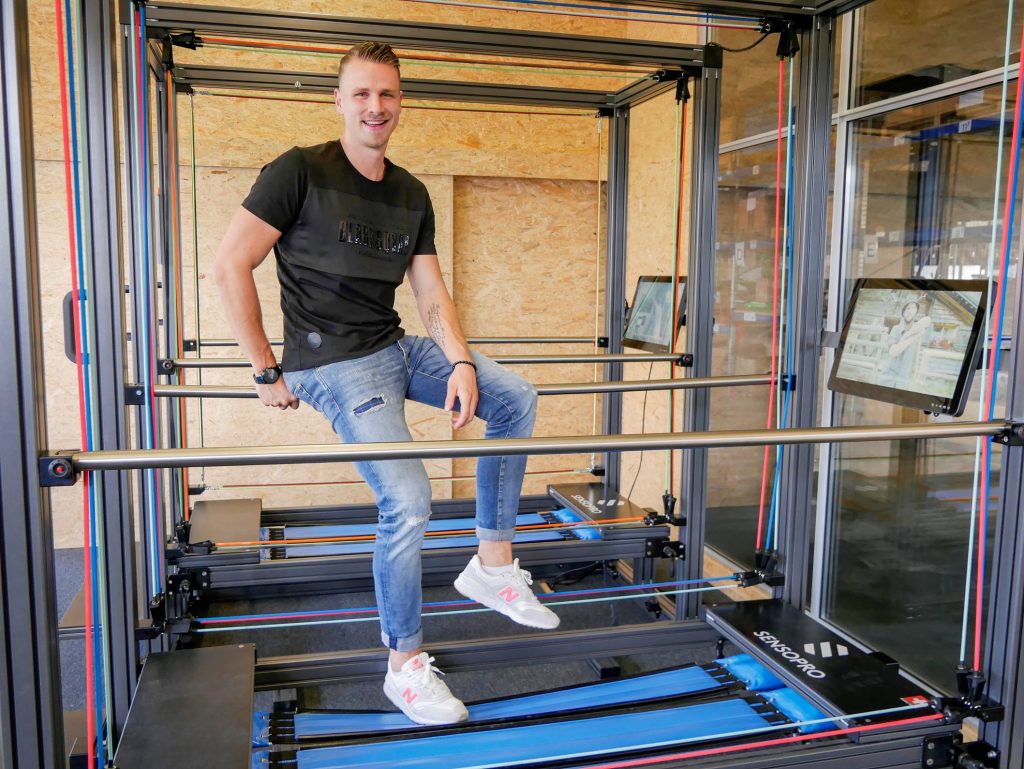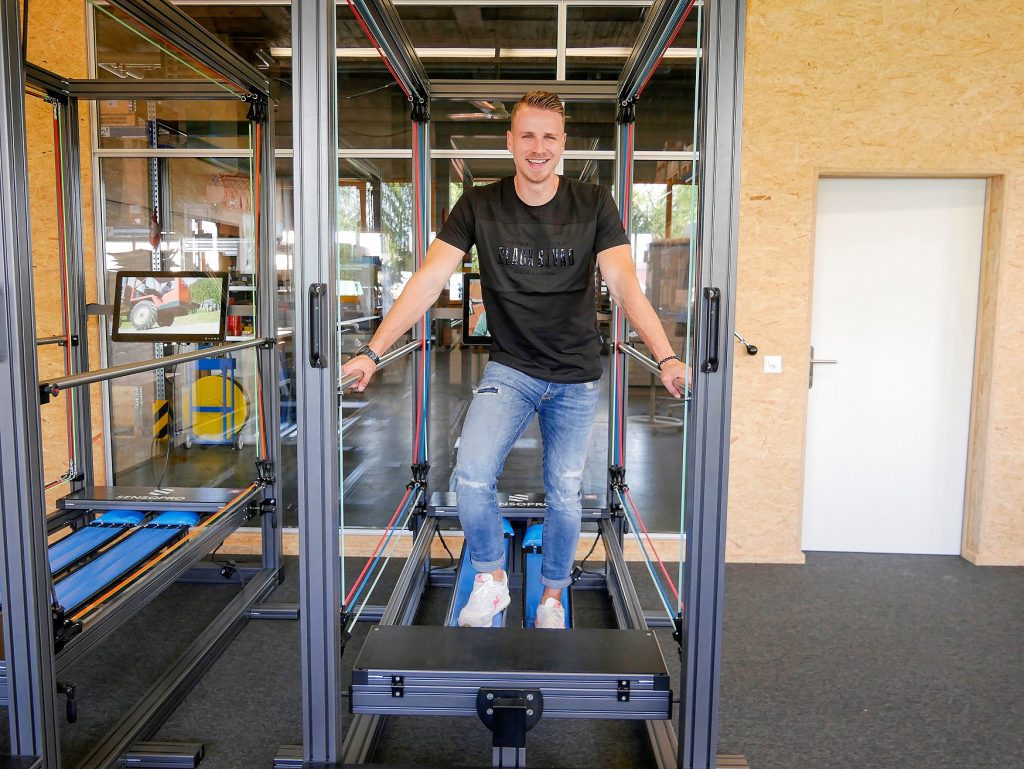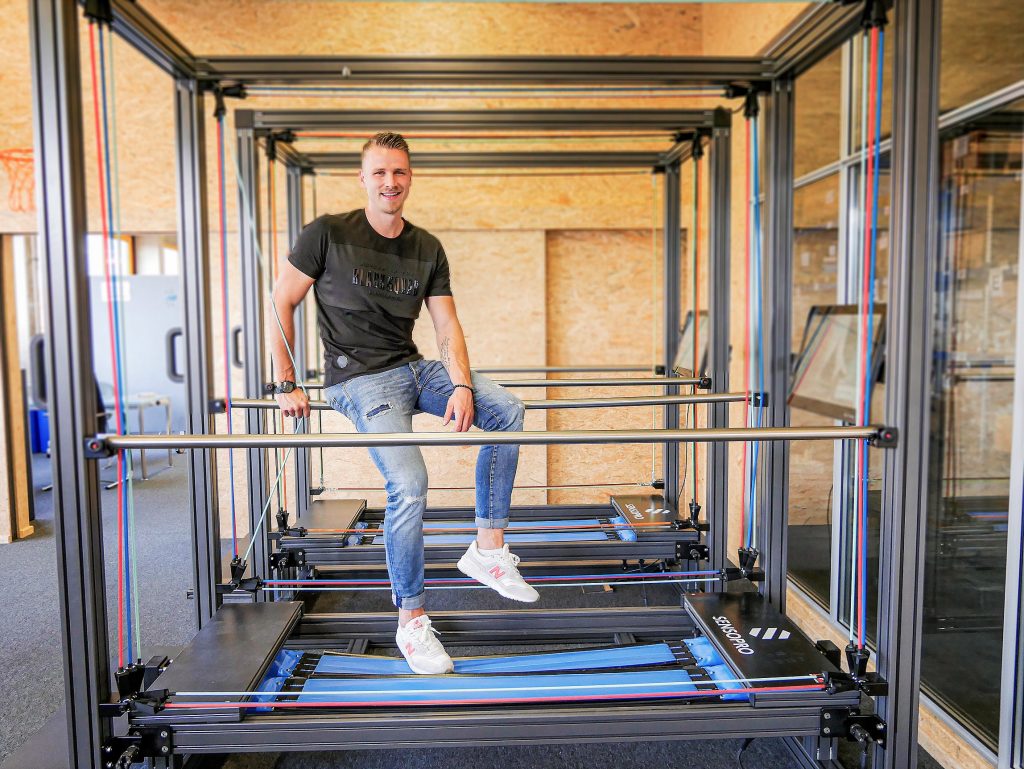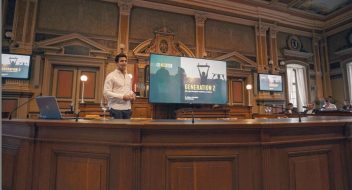How can you start a new fashion brand and make it recognizable? Dr. Mukta Ramchandani,…
Kaspar Schmocker
Founder of SensoPro AG

Kaspar Schmocker breaks all entrepreneurial stereotypes. It took him 7 years, 5 prototypes and several injuries to develop this unique sports machine, but he refuses to see today’s success as his own achievement. For several months after the launch of SensoPro, he received only rejections and could not even place the machine for free, yet he considered any NO as a positive sign. Four years later his machine remains one of a kind worldwide, but he can hardly wait for it to be copied by other companies.
At the age of 31, Kaspar runs the international business, improves the lives of Parkinson’s patients, fitness center customers and sports celebrities through coordination training, and aims to build the best sales team in Switzerland. In this interview, he explains how to create demand for a brand new product, why fun is at the core of his business concept, and why you should never think that you are the smartest person in the room.
Kaspar, let’s start with your childhood. What were your interests at that time? What profession did you dream of?
Actually, I didn’t have a dream profession, but I was sure it shouldn’t be a boring office job. When I was a child, I was fully into sports: Running, playing football, basketball, tennis. I was curious about all kinds of movements and after school I decided to deepen my knowledge in this field. So I chose to study sports science at the University of Bern.
What career opportunities would you have had afterwards?
Usually you can either continue working at the university or choose a career as a sports teacher. But none of these options really touched my heart. What caught my attention during my studies, however, was a project that we once worked on – developing a company and selling new sports products. It sparked my interest and I could feel that this was what I wanted to do, but I didn’t really know where it would lead. There was an interview I once read with a Spotify founder in which he said that before founding this company he felt like he was in an airplane above the clouds; he knew it was going to land somewhere, only he didn’t know exactly where yet. I like this metaphor very much and can relate to it.
What brought you to the idea of developing a coordination training machine?
Parallel to my studies I played for the university hockey team and took part in the national championship. There you have to train like a pro. At one moment the topic of coordination caught my eye. I recognized that it is an important part of training in the high-performance sector, and it might be useful for everyone. But in regular fitness or physiotherapy studios there was very little opportunity to work on coordination, there was no specific device that would offer a complex solution. That’ s how I got the idea to develop such a machine.
At first it was like a hobby: Every Saturday and Sunday my uncle and I worked on a prototype, developed the machine, tested it.
What exactly is coordination and why is it so important?
Coordination is what makes your body use the right muscles, in the right way and at the right time. The human body has about 650 muscles, and in every situation they have to work together. The better they work together, the less energy you need and the better you can multitask. Coordination makes your movements smoother, more efficient and helps prevent injuries. That is why this ability is absolutely crucial.
It took you 7 years from creating an idea to starting the business. Why so long?
At first it was like a hobby: Every Saturday and Sunday my uncle and I worked on a prototype, developed the machine, tested it. We didn’t think about starting a company then, we just did it out of curiosity. We researched, tried out different features. So we found out that there was no coordination tool to work from behind the body, so we created back tubes. Then it appeared that in order to keep you safe in such 3D training, we had to build a protective cage. We also found that the bouncing surface is more effective when your legs work independently, so we cut the trampoline in the middle and transformed it into two tapes. Every step was like playing with ideas and their implementation.
When did you eventually start a company and how did it happen?
One day, when we achieved our first successes and were more or less satisfied with the results, the idea became clearer. I guess it was a combination of fire, knowledge and the feeling that we could really win some customers with this product. At the same time several new people joined us, and we decided to just do it. In 2015 we founded a GmbH with the aim to develop and sell sports and fitness machines.
Was the beginning successful for you? Did you find customers easily?
Not at all! Not only couldn’t we sell the machine, it was also a struggle to place our equipment anywhere for free. We really begged the gyms to take it free of charge so that people could test it, but we only got rejections. It was frustrating. There were days when I thought it was a waste of time. Now when I look back, I sometimes ask myself: How did you manage it and didn’t give up? It was really tough.
We were asked how many machines we have already sold. When the answer was “zero”, our chances of selling one fell almost to the same number.
Why was it so complicated? You created a good product, researched it and even had connections on the sports field – that sounds like a perfect setting for a great start.
I think the first reason is the specifics of the Swiss market: people in business are really critical. It’s a positive thing in general, but a hard one for start-ups. We were asked about conducted studies, proven results and how many machines we have already sold. When the answer was “zero”, our chances of selling one fell almost to the same number. In addition, our marketing and sales strategy was not very clear at first, we were amateurs. Furthermore, when we launched SensoPro, nobody thought they needed coordination training, there was no demand.
How did you generate the demand? What are your key points when selling SensoPro devices?
My father always told me: The company is worth as much as the problems it helps to solve. We knew that top athletes regularly worked on coordination and we believed that everyone could benefit from such training as well. But in fitness and physiotherapy, such a training setting was difficult to organize. Earlier there were only many small tools that were either complicated or had to be used under supervision. We offered a solution to this problem in an all-in-one machine that is not only easy to use, but also fun for the customer.
Photos: @sensopro
How does your machine make coordination training fun?
Balancing is not boring per se. Everyone knows how much joy children have on a trampoline: Jumping, bouncing, stabilizing. With SensoPro you learn various movements during training, and they become more complicated over time, so that you are always a little challenged. This process is really fun, and we can see it on the happy faces of our customers. At the same time, coordination training improves your endurance, strength and flexibility. This allows you to better control your movements in everyday life and improve your performance in other fitness trainings.
Sounds really great. So with this philosophy and active sales approach, you’ve succeeded in winning first customers, right?
Yes, after several months of making 30-40 cold calls every day and receiving only rejections, we finally got lucky and sold our first machine. But maybe you just have to work hard to get lucky one day. Since then we have drastically improved our sales skills and that is still our priority today.
For me, any NO means getting one step closer to a YES.
After so many tough months, what has helped you to carry on and remain persistent?
I’ve learned that everything is a matter of perception. Of course, when you get a rejection, you might feel frustrated, but you need to see the bigger picture. Somehow, I intuitively realized that every new call brings me closer to selling. For example, 30 calls will probably lead me to three meetings and one sale. Then you just calculate how much a call is worth. For me, any NO means getting one step closer to a YES. Of course, you need to learn how to do it properly, how to find the right tone and the right language. But once you have found it, such an active sales approach is really functional.
You are a sales manager and sales coach in your company. Why did you choose this role in particular?
I was always into sales. I remember when I was 12 years old my grandmother offered me to sell one of her paintings to earn some pocket money. When I asked her what the price should be, she told me a thousand francs. I said: Ok, but for how much would you really want to sell it? Eventually I sold it for 2800 francs convincing a customer with a ‘special offer only available today’ and some kind of credit terms. So I was always passionate about selling and of course later deepened my knowledge in this area.

Can you share some sales tips and strategies that you find particularly useful?
There are plenty, so I’ll just give a few examples. There is a technique for starting negotiations that I call ‘Win the room’. When I have a sales meeting, I always come 15-20 minutes earlier and try to communicate with everyone I can. Talk to the secretary, talk to the employees, create a positive atmosphere. So that when the decision-maker comes, he has the feeling that you are already part of this company, you are involved. Our other rule is not to talk about SensoPro for at least 5-10 minutes. In the negotiations, we first talk about everything but our product. Of course, these are just small details. Our approach is dynamic, we constantly evaluate what worked well and what didn’t, and modify the sales techniques we use.
Were there mistakes or wrong decisions you made during development?
One of the wrong approaches was to start from a high-performance sector. Well, it was of course a great achievement for us when we sold our machine to an NBA superstar Kevin Durant. It was also a very nice trip to Beverley Hills. But it was the wrong timing because we weren’t ready to supply the market. We don’t have any production or distributors in the USA and customers couldn’t find SensoPro there. That’s when we realized that we first need to focus on the B2B sector, covering one region at a time. In every market we try to make SensoPro available in as many gyms and physiotherapy centres as possible and only then advertise through celebrity athletes.
In which markets are you already active and which are coming next?
Currently we are in Switzerland, Germany, Austria, Russia, South Africa and have one machine in the USA. In the near future we plan to enter Scandinavian countries and then hopefully cover the whole of Europe. We produce the machines here, and with this capacity we can supply all European countries. In the future, we also want to scale up in the USA, which could become one of our largest markets. But in order to go overseas, we probably need to have production there. It’s another amount of investment, so we want to tackle it strategically.
What other growth directions do you consider?
One idea is to introduce a machine that you can use at home; another is to offer a machine for group fitness. We already have several new prototypes and will see which one will be presented next. It depends on the market. As long as we have no competition and our business is running well, we will not be forced to launch new products too early. But if tomorrow we were copied by a larger company, we would probably have to make rapid changes. To tell you the truth, sometimes I even want our machine to be copied. I think it will be a great challenge for us and the start of new developments.
I am very action-oriented, and it can probably be exhausting for others.
Speaking of challenges and accomplishments, what were the most inspiring moments of your work in SensoPro?
First of all, I get really emotional when I get feedback from machine users who write to me to say that they no longer have pain thanks to this training. It touches my heart because it’s much more than just a financial gain – it’s a chance to bring real benefits to others. The second is right here: this place, these people. We have a fantastic team and I’m just happy to be working with them. I wouldn’t trade it for any money in the world, because, as the saying goes: shared joy is double joy. The third thing that makes me happy is the machine itself: when I see how people enjoy training and in how many places it is already available. I am very proud of our team and that we made it possible together.
Regarding teamwork: How would you describe yourself as a manager? What is your leadership style?
I am very action-oriented, and it can probably be exhausting for others. So I am very happy that they are still working with me. I also have a very close relationship with everyone in my team, we are like a family. It is important to me to really feel and understand people, so I try to create an open and positive environment.

What do you value most about people?
Being able to have fun together. I really have a hard time performing when everything is too serious. And I appreciate honesty and openness when we cannot only talk about positive things, but also about fears and anxieties. When we talk about how perfect and great everything is, I call it the dead middle and try not to go there. So, either deep honest conversations or funny stupid things, but no small talk about nothing.
I believe that structure beats the process. It’s not always a good thing to wait until you have enough resources.
And from a business perspective, which entrepreneurial skills do you see as crucial?
First of all, you need to understand what your strengths are weaknesses are. When you understand your weaknesses, you can hire a team to complement them. That’s the next important thing – finding the right people. As for me, I always listen to my gut feeling when hiring people, but that’s of course individual. Finally, after hiring a team, you should learn how to delegate and try not to keep everything under control. It’s hard to grow when you do everything by yourself, so it’s very important to build a team in the early stages of business development.
Isn’t it the question of resources? To hire a team, you need investments that novice entrepreneurs do not always have.
This is again a question of perspective. Actually, I had the same thoughts at the beginning, but today I believe that structure beats the process. It’s not always a good thing to wait until you have enough resources. Sometimes you first have to build a proper structure to make your project grow.
Was this the reason you hired CEO and management team from the very beginning?
Yeah, that was the first reason. The second is that I am more of a visionary than a business strategist. If I work too long on something, I get bored. That’s why it was very important for me to stay creative and at the same time have strong support in other business areas. I needed someone with experience in finance, sales and development so that I could continue to focus on ideas and sales.

What tips can you give to young entrepreneurs who are just setting off on their path?
Be curious, ask questions and learn from as many people as possible. It is important to have an open mind and never think that you are the smartest person in the room. If you think that, you are simply in the wrong room. Secondly, do your work properly no matter what stage of development you are at. Whether you speak in front of 10 or 10,000 people, prepare at the same level. If you do everything professionally, achieving great results is only a matter of time.
Thirdly, once you have succeeded, always remember your path and try to help those who are still taking their first steps. And finally, work on your network. At least that’s what works for me: I try to be as networked as possible, in all possible areas. I intentionally meet people with whom I want to make contact, as well as willingly introduce people to each other.
What role does the network play for your business?
It’s everything, really. We gain new customers, new partners and even new markets thanks to our network. In addition, a diverse network helps you to identify opportunities and find new creative ways of doing business. I think there’s so much room for something new in Switzerland today, you only have to recognise the free niches. Of course, this also means that there are many chances of failing, but entrepreneurship is always a risk. It’s no fun doing business if you’re not ready to make mistakes.
Thank you very much for this interesting conversation and useful tips! We wish you all the success with your projects!
Learn more about SensoPro:
CONTACTS
Website: https://sensopro.swiss/
Instagram: https://www.instagram.com/sensopro/
Facebook: https://www.facebook.com/Sensopro/
YouTube: https://www.youtube.com/channel/UCS1ywjRXUtNZt2f9155tzMA

















